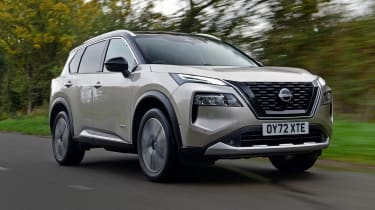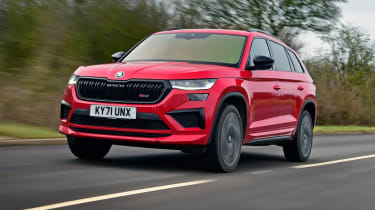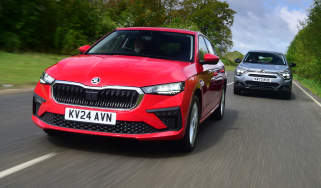Top 10 best large SUVs to buy 2024
Need a practical family car? Look no further than the best large SUVs on sale today
There was a time not so long ago when even the best large SUVs (Sport Utility Vehicles) were clunky, bouncy, woolly handling behemoths that sucked fuel at a frightening rate. Now, though, thanks to significant developments made by manufacturers, drivers can enjoy the high-riding driving position, imposing road presence, and enormous practicality of a large SUV, but in a far more comfortable and affordable way.
Why the big changes? It didn’t take car companies long to realise that most of their large 4x4 buyers weren’t at all interested in the off-road capabilities of their chosen transport, and never strayed farther off tarmac than an occasional muddy car park.
With this realisation came a trend for the current class of large SUVs, which sometimes nowadays don’t even bother with the added complication of four-wheel drive. Instead, modern trends mean the best large SUVs – or at least the most popular ones – focus very much on the ease of driving, good road handling, comfort and practicality, with less regard for the requirement to go off-road.
That means it’s rare to find a big SUV these days with a rugged separate chassis; a feature that was once the hallmark of a serious 4x4 is now largely limited to commercial off-roaders and double-cab pick-ups. Even those large SUVs that do retain significant off-road ability have benefited from the need to appeal to parents on the school run. So you’ll no longer find clunky low-ratio gear selector levers or manual locking differentials, as advances in electronic chassis control systems mean everything is taken care of automatically.
Top 10 best large SUVs to buy 2023
So which is the best large SUV to buy right now? We’ve listed our top 10 choices, based on our extensive testing of every SUV on the UK market, in reverse order below to help you make the right choice.
10. Volvo XC90
Classy styling, a luxurious interior and varied engine range all make the Volvo XC90 a great alternative to the Land Rover Discovery, especially if you want a plug-in hybrid SUV.
While the XC90 falls a little short of the Discovery in terms of interior space, it’s a very practical car. There’s loads of room for five people plus luggage, but the rearmost seats are only really suitable for occasional use. Elsewhere, the XC90 gets a great infotainment system, lots of safety equipment and some of the best seats available in a production car.
Key to the XC90’s appeal is its engines. The best choice for most is likely to be the mild-hybrid B5 diesel with its good combination of performance and economy; at the other end of the price range, the T8 Twin Engine plug-in hybrid is a fast yet frugal choice if you keep its batteries topped up.
9. Audi Q7
The big Audi SUV shares its engineering platform with the Bentley Bentayga, Porsche Cayenne and VW Touareg, taking advantage of the very best of the VW Group’s technical know-how, yet retaining its own distinctive brand ‘DNA’ – from behind the wheel it feels very much an Audi.
In spite of its bulk, the Q7’s advanced chassis engineering (with optional four-wheel steering and adaptive air suspension) means it’s a rewarding and fun car to drive. It’s manoeuvrable around town yet has bags of grip and stability when you’re out on the open road and handles with surprising agility thanks in part to its relatively low weight. It’s comfortable too, but the relatively sporty feel means it’s not quite as luxuriant over bumps as a Range Rover.
A pair of smooth, powerful and efficient diesel engines and a standard eight-speed Tiptronic automatic gearbox all help to make the Q7 a compelling choice for luxury SUV buyers.
8. Peugeot 5008
The 5008 is a stylish, more luxurious alternative to rivals such as the SEAT Tarraco and Skoda Kodiaq. It’s a sharp, handsome SUV with a dramatic interior that feels special. It’s well equipped, too, with Peugeot’s digital i-Cockpit, dual-zone climate control, a reversing camera, and a safety pack that adds blind-spot detection and lane-keep assist to make motorway journeys a painless experience.
The Peugeot rides smoothly and is just as comfortable as its closest rivals. It doesn’t offer the last word in driving dynamics, but few SUVs of this size can; instead, the 5008 concentrates on comfort and practicality.
With the seats in the third row folded there’s a 702-litre boot, while the middle row slides back and forth as required to give passengers more space if needed. Getting into those rearmost seats isn’t the easiest job, but they’re still perfectly usable by adults. Elsewhere, the 5008 has 38 litres of cubby space dotted around the cabin, which is a nice family-friendly touch.
7. BMW iX
You should never judge a book by its cover – and when it comes to cars, no model proves this point better than the iX. Controversial looks mean the BMW stands out for all the wrong reasons, but on the move, the brand’s flagship EV is a class act.
As you’d expect of a range-topping BMW, refinement is first rate, while the twin-motor all-wheel-drive set-up delivers strong performance, especially in the hot 610bhp 60M edition.
Despite its high 2.5-tonne kerbweight, the iX handles with surprising precision and agility, while the supple ride takes the sting out of bumps and potholes. Other highlights include the spacious and luxurious interior, along with cutting-edge tech and a claimed range of up to 380 miles.
6. Land Rover Discovery
The latest Land Rover Discovery marked a shift of emphasis for the model, away from the uncompromisingly rugged appeal of its boxy predecessors, and closer to the more softly styled mainstream of luxury SUVs.
That’s not to say the Disco is any less proficient off-road than its predecessors, because it’s still all-but-unbeatable when the going gets tough. But it does mean the Discovery is more car-like, more refined and more luxurious than ever before. This should make it an alluring choice for those buyers who value looks, image and seven-seat practicality above go-anywhere credentials.
In other words, the school-run drivers who were put off by the last Discovery’s macho style should find the current model less challenging. It’s also a bit more efficient thanks to an entry-level 3.0-litre diesel option offered next to the 300bhp+ top models, as well as the option of a mild-hybrid drivetrain.
All Discovery variants come with electronic air suspension, eight-speed automatic gearbox and Land Rover’s Terrain Response system that optimises the car for any surface it encounters. On tarmac, the Discovery is tuned for comfort rather than speed, but easy, relaxed manners and a cavernously practical, well-equipped cabin make it the ultimate family-hauler.
5. BMW X5
BMW took a bit of a gamble when it launched the original X5 in 1999, but it paid off handsomely. The German machine was one of the first models to prove that SUVs could be good to drive on the road, and it continues to set the class standard for driver satisfaction.
Today, it’s still undeniably a big car, but the combination of quick, well weighted steering, tight body control and strong grip means the X5 feels remarkably light on its feet. It’s also powered by a range of silky-smooth six-cylinder engines, and there’s even a scorching 617bhp X5 M version. However, it’s the 45e’s plug-in hybrid powertrain that best suits the BMW, thanks to its blend of effortless power and 54 miles of electric range.
Adding to the car’s appeal, the interior is vast, lavishly appointed and crammed with tech, plus there’s also a versatile seven-seat option, and every model comes as standard with four-wheel drive. Factor in hushed refinement and a plush ride, and the X5 is an SUV with very few chinks in its armour.
4. SEAT Tarraco
The SEAT Tarraco is a close relative of the Skoda Kodiaq, which means it’s a large seven-seat SUV engineered primarily for road use. That makes it a more fashionable alternative to a traditional MPV, although the Tarraco’s somewhat confined rear row of seats means it’s not ultimately as practical.
While it shares much of its hardware with its Skoda stablemate (that’s the VW Group ‘stable’ to which SEAT and Skoda both belong), the Tarraco rides a couple of centimetres closer to the ground than the Kodiaq, part of an engineering package that makes its handling responses just that little bit sharper. It’s arguably more sharply styled too, and generally a bit nicer to drive, although the 1.5-litre petrol engine can feel a bit strained compared with the 2.0-litre petrol and diesel.
You won’t be wanting the Tarraco for serious off-roading, so the two-wheel-drive version will satisfy most owners. Those who want to tow trailers or live in areas where extreme weather is commonplace can choose four-wheel drive.
3. Nissan X-Trail
While previous Nissan X-Trails were boxy and utilitarian, the latest iteration is a much more refined and modern offering. Everything feels well put together and all but the entry-level Visia trim feature plenty of on-board technology, too.
The latest X-Trail is much more comfortable to drive than previous generations, and it’s adept at cruising along the motorway. There aren’t exactly many thrills to be had, so if you’re after a sporty experience then it’d be best to look elsewhere. But if you want a calm and sensible family car, the Nissan is a solid choice.
All X-Trails are powered by a 1.5-litre three-cylinder petrol engine, but different variants use it in different ways. Standard models use the engine in a traditional sense, alongside mild-hybrid tech. Meanwhile, the X-Trail e-Power utilises the engine as a range-extending generator. Instead of providing drive, its purpose is to charge the on-board battery pack which then powers an electric motor. This helps to keep CO2 emissions down to a claimed 132g/km.
This powertrain doesn’t offer the same levels of efficiency as a plug-in hybrid, but it’s still good for up to 48.7mpg on the WLTP combined cycle, compared to regular X-Trails which are capable of returning over 38mpg at best. While this level of fuel economy isn’t particularly amazing, the Nissan’s safety is top-notch with its five-star Euro NCAP safety rating. Its suite of safety tech includes automatic emergency braking, forward collision warning, lane-keep assist, blind-spot warning, and traffic sign recognition.
2. Kia Sorento
The latest Kia Sorento saw a notable price increase over the previous model, but the quality also took a significant step up with it. For your money you’ll get a seven-seater that’s filled with impressive yet easy-to-use features, a huge amount of cabin and luggage space and – perhaps most importantly for a family SUV – a class-leading amount of safety tech as standard.
The Sorento is proving popular with owners, too, as they ranked it as the second best car to own in our 2023 Driver Power customer satisfaction survey. Owners praised the Sorento’s infotainment system and exterior design in particular, along with the interior and practicality.
Engine options include a 1.6-litre petrol-hybrid, a 1.6-litre plug-in hybrid, or a 2.2-litre diesel. The diesel is smooth and quiet, and far less coarse than some other large diesel SUVs. The 0-60mph sprint takes 9.1 seconds, which isn’t bad for a car that weighs more than two tonnes. There is some body roll in corners, but you can expect that in a car that’s set up for comfort. If you’re after lower emissions, the Sorento PHEV offers up to 35 miles of pure-electric range.
The interior has been finished to a high standard, and Kia has bucked an annoying trend by retaining physical controls for the climate control. The infotainment system works very well, and the Sorento is the first car ever to project rear traffic onto the screen so you can monitor your blind spots. It can even park itself.
1. Skoda Kodiaq
The Skoda Kodiaq is a great all-rounder that offers pretty much every quality that you could want from a large SUV – especially if you’re using it as a family car. It’s comfortable, practical, well-built, affordable and even offers seating for up to seven people. This is such a winning combination that we’ve named it our Large SUV of the Year two years in a row in 2022 and 2023.
It’s also good to drive, and handles corners with composure, despite its bulky size. The 1.5-litre petrol and 2.0-litre diesel engines both offer reasonably punchy levels of power while returning up to 40.8mpg and 52.6mpg, respectively.
Inside, you will find a typically straightforward but pleasantly designed interior. The materials used throughout are of a good quality, and Skoda’s infotainment system is easy to use. The optional Virtual Cockpit swaps the Kodiaq’s traditional dials for the Volkswagen Group’s customisable digital instrument display.
It’s the practical touches that really give the Skoda its unique appeal, though, and the brand’s ‘simply clever’ ethos is backed by useful features such as umbrellas in the doors, an ice-scraper behind the fuel filler cap, and underfloor storage in the boot. It all adds up to a superb choice for families.
Top 10 best large SUVs
- Skoda Kodiaq
- Kia Sorento
- Nissan X-Trail
- SEAT Tarraco
- BMW X5
- Land Rover Discovery
- BMW iX
- Peugeot 5008
- Audi Q7
- Volvo XC90
Like the idea of maximum practicality but with lower emissions? Check out our list of the best hybrid SUVs…









_barzku.jpg)









